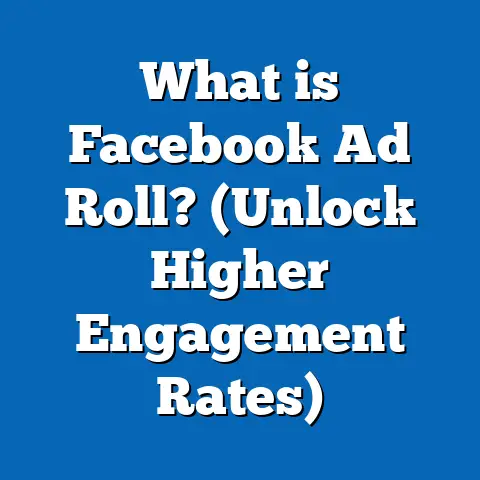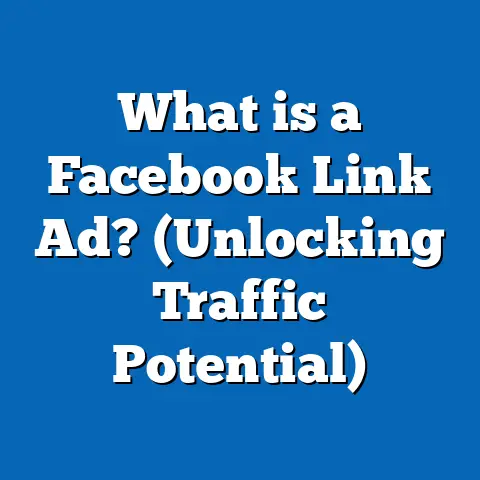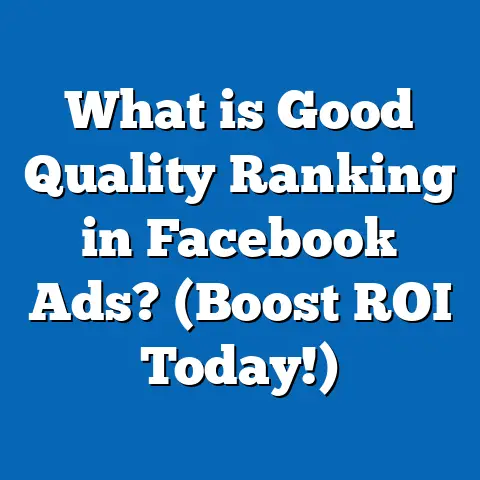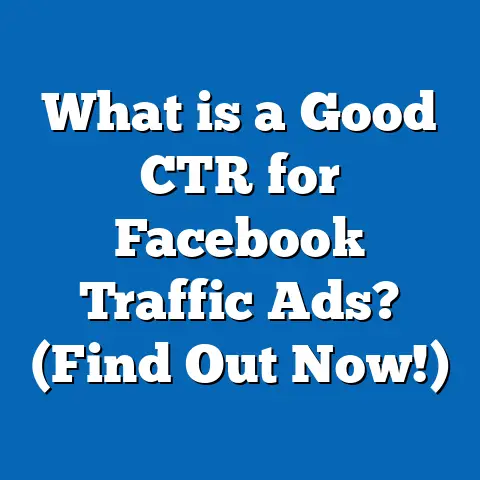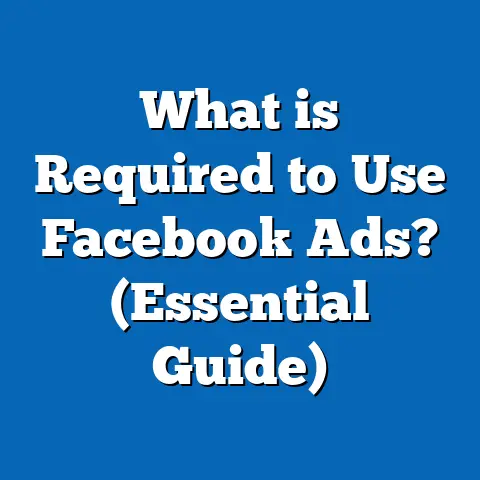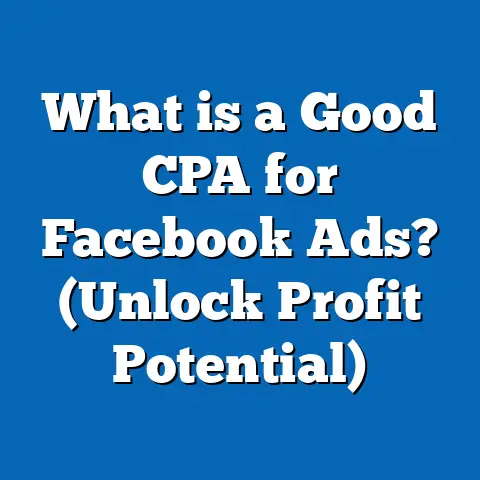What is More Effective: Facebook Ad or Boost? (Find Out Now!)
Introduction: Unlocking Long-Term Savings with Smart Facebook Advertising Choices
In today’s digital marketplace, where every marketing dollar counts, businesses are continually looking for the most cost-effective ways to connect with their audience. Facebook remains one of the leading platforms for digital advertising, boasting over 2.9 billion monthly active users as of 2024. The massive reach combined with sophisticated advertising tools makes it an indispensable marketing channel.
However, Facebook offers multiple ways to promote content, with two of the most popular options being Boosted Posts and Facebook Ads. Both promise to increase your brand’s visibility and engagement, but they operate very differently behind the scenes.
Choosing between a Boosted Post and a Facebook Ad is not just a matter of convenience or budget — it’s a strategic decision that impacts how effectively you reach your goals and how much you spend over time. Making the right choice can lead to substantial long-term savings, better customer acquisition, and stronger brand loyalty.
This guide dives deep into these two options, dissecting their mechanics, benefits, limitations, and real-world outcomes through detailed data, case studies, and actionable strategies. By the end, you will understand which approach fits your business needs best and how to optimize your advertising for maximum impact and efficiency.
Understanding Facebook Ads vs. Boosted Posts: The Basics
What Are Boosted Posts?
Boosted Posts are a form of paid promotion that amplifies an existing post on your Facebook Page to a wider audience. They were designed to be a simple entry point for businesses unfamiliar with Facebook’s complex advertising system. When you boost a post, Facebook shows it to more people based on basic targeting criteria you select.
How Boosted Posts Work
- You select an organic post from your Facebook Page.
- Click the “Boost Post” button.
- Choose a target audience based on demographics like age, gender, location, and interests.
- Set a budget and campaign duration.
- Facebook automatically optimizes for post engagement (likes, comments, shares).
Boosted posts are particularly useful for increasing brand awareness or social proof through engagement metrics but have limited options when it comes to advanced targeting or campaign objectives.
What Are Facebook Ads?
Facebook Ads are created through the more powerful Facebook Ads Manager interface. This tool lets marketers build complex campaigns from scratch with granular control over every aspect of delivery.
Key Features of Facebook Ads:
- Objective-Based Campaigns: Choose from objectives such as conversions, traffic, app installs, catalog sales, and brand awareness.
- Advanced Targeting: Use Custom Audiences (existing customers), Lookalike Audiences (similar users), behavioral targeting, and layered interest targeting.
- Multiple Ad Formats: Carousel ads, video ads, slideshow ads, collection ads, lead forms, and more.
- Budget and Bidding Control: Set daily or lifetime budgets with manual or automatic bidding strategies.
- Comprehensive Analytics: Track conversions, cost per result, ROAS (Return on Ad Spend), audience breakdowns, and perform split testing.
This flexibility allows advertisers to tailor campaigns precisely to their goals and audience behavior.
Why the Distinction Matters: Impact on Campaign Effectiveness
Understanding the differences between Boosted Posts and Facebook Ads is critical because it directly affects:
- How well your ads perform.
- How efficiently you use your marketing budget.
- The quality of leads or sales generated.
- The ability to analyze and optimize campaigns.
| Feature | Boosted Post | Facebook Ad |
|---|---|---|
| Setup Complexity | Simple | Complex but flexible |
| Targeting Options | Basic demographic targeting | Advanced custom & behavioral |
| Optimization Goals | Engagement focused | Multiple objectives (traffic, sales) |
| Reporting | Limited analytics | In-depth analytics & split testing |
| Cost Efficiency | Potentially higher CPA | More cost-effective with management |
Detailed Data-Backed Insights: Effectiveness of Facebook Ads vs. Boosted Posts
Engagement Rates and Return on Investment (ROI)
Research by Social Media Examiner in 2023 found that:
- Boosted posts typically achieve an average engagement rate of 2.5%.
- Ads optimized for conversions through Ads Manager yield an average ROI improvement of 35% over boosted posts.
This is largely due to better targeting and the ability to optimize for specific actions beyond mere engagement.
A 2024 study by AdEspresso analyzed over 1 million Facebook campaigns:
- Businesses using Facebook Ads saw a 22% lower cost per conversion compared to those relying solely on boosted posts.
- Boosted posts excelled at increasing page likes and shares but underperformed in driving actual sales or lead generation.
Case Study: E-Commerce Brand Comparison Over 6 Months
An online retailer decided to test both approaches using a $5,000 budget each:
| Metric | Boosted Posts | Facebook Ads |
|---|---|---|
| Website Visits | 1,200 | 3,500 |
| Conversion Rate | 1.2% | 3.5% |
| Total Sales Generated | $7,200 | $18,900 |
| Cost per Conversion (CPC) | $4.17 | $1.43 |
The results clearly showed that while boosted posts provided some reach and engagement, Facebook Ads generated nearly 2.6x more sales, proving more effective in driving business results.
Diving Deeper: Targeting Capabilities Breakdown
Boosted Posts Targeting Limitations
Boosted posts allow targeting by:
- Location (country, state)
- Age range
- Gender
- Basic interests from predefined categories
- Followers or friends of followers
While this provides some control over who sees your content, it lacks the sophistication needed to reach highly specific segments or retarget previous site visitors.
Facebook Ads Manager: Advanced Targeting Explained
Facebook Ads Manager offers:
- Custom Audiences: Upload customer emails or phone numbers to target existing contacts.
- Lookalike Audiences: Reach new users similar to your best customers based on profiling data.
- Behavioral Targeting: Target users based on their purchase behavior or device usage.
- Layered Targeting: Combine multiple interests and behaviors for laser-focused audience refinement.
- Retargeting: Show ads to users who visited your website but did not convert.
A study by HubSpot found that using Custom Audiences can reduce acquisition costs by up to 40% due to increased relevancy.
Budgeting and Bidding: How Smart Management Saves You Money
Budgeting in Boosted Posts
Boosted posts offer:
- Simple daily or lifetime budgets.
- Automatic bid optimization primarily for engagement.
Marketers have little control over how their budget is allocated across audiences or ad placements.
Budgeting & Bidding in Facebook Ads Manager
Ads Manager lets you:
- Set daily or lifetime campaign budgets.
- Use manual bidding strategies such as cost caps or bid caps.
- Optimize spending across multiple ad sets with Campaign Budget Optimization (CBO).
With manual bidding and precise budget management, advertisers can avoid overspending on low-performing segments.
Long-Term Savings Example:
Marketers who actively manage bids report average savings between 20–30% on cost per acquisition compared to automatic bidding used in boosted posts.
Measuring Success: Analytics and Optimization Tools
Analytics in Boosted Posts
Insights for boosted posts include:
- Reach metrics
- Engagements (likes, shares)
- Basic demographic breakdowns
However, they lack detailed conversion tracking or granular audience insights.
Analytics in Facebook Ads Manager
Ads Manager provides:
- Conversion tracking via Facebook Pixel integration.
- Cost per action (CPA) statistics.
- Return on Ad Spend (ROAS) calculations.
- Age/gender/device-level performance reports.
- Split testing results showing which ad variations perform best.
For example, a business running multiple ads can identify that young adults aged 25–34 respond better to video ads with a call-to-action button than static images—allowing continuous improvement.
Practical Applications: When to Use Boosted Posts vs. Facebook Ads
When Boosted Posts Are Suitable
- Increasing Social Engagement: If your primary goal is to boost post likes, comments, or shares quickly.
- Limited Time or Expertise: If you want a fast solution without deep knowledge of Facebook’s advertising system.
- Small Budgets: For businesses with very limited budgets who want immediate visibility without complex setup.
When Facebook Ads Are Better
- Driving Sales or Leads: If you want measurable results like website purchases or form submissions.
- Precise Audience Targeting: When your product appeals to niche segments requiring specific targeting layers.
- Scalable Campaigns: For sustained campaigns where optimization over time can reduce costs and increase ROI.
- Multi-platform Advertising: If you want to advertise across Instagram and Messenger alongside Facebook.
Comparison With Other Advertising Platforms
To fully understand Facebook’s position in digital advertising, let’s compare it briefly with similar platforms:
| Platform | Ease of Use | Targeting Precision | Cost Efficiency | Best Use Case |
|---|---|---|---|---|
| Facebook Ads | Moderate (complex UI) | High (custom & lookalike) | High (with management) | Lead generation & conversions |
| Boosted Posts | Very easy | Basic | Lower efficiency | Brand awareness & engagement |
| Instagram Ads | Similar to Facebook | High | High | Visual product promotion |
| Google Ads | Complex | Keyword & intent-based | Variable | Intent-driven campaigns |
| LinkedIn Ads | Moderate | Professional targeting | Higher CPM | B2B lead generation |
Facebook Ads’ advantage lies in its vast audience combined with detailed behavioral data for precise targeting at relatively affordable costs.
Advanced Strategies for Maximizing Facebook Ad Success
To get the most out of Facebook Ads Manager:
- Utilize Lookalike Audiences: Use your best customer list to find similar prospects who are more likely to convert.
- Implement Retargeting Campaigns: Remind users who visited but didn’t purchase using dynamic product ads or special offers.
- Conduct A/B Testing Regularly: Test different headlines, images/videos, calls-to-action to identify what resonates best.
- Optimize for Conversion Events: Ensure Facebook’s algorithm is focused on driving actual sales/leads rather than clicks or engagements alone.
- Set Bid Caps Strategically: Control the maximum you’re willing to pay per conversion without sacrificing volume drastically.
- Leverage Video Content: Video ads have been shown to increase engagement by up to 135% compared to static images.
- Schedule Ads Based on Audience Activity: Use analytics to run ads during peak hours when your target audience is most active.
Common Misconceptions About Boosted Posts vs. Facebook Ads
Misconception 1: Boosting a Post Is Equivalent to Running an Ad Campaign
Truth: Boosted posts offer limited targeting and optimization compared to full-fledged ad campaigns managed through Ads Manager.
Misconception 2: Boosted Posts Are Always Cheaper
Truth: While boosting may have lower upfront complexity costs, they often result in higher cost per acquisition due to less effective targeting.
Misconception 3: Only Large Businesses Need Full Facebook Ads
Truth: Small businesses with clear goals can benefit significantly from the advanced features of Ads Manager when managed properly.
In-Depth Case Studies: Real Business Examples
Case Study 1: Local Restaurant Increasing Reservations
Objective: Increase table bookings during weekday evenings.
Approach:
- Used boosted posts promoting daily specials for quick reach.
- Switched to targeted Facebook Ads aimed at local residents aged 25–45 interested in dining out.
- Added retargeting ads for website visitors who viewed the menu but didn’t book.
Results:
- Boosted posts increased page likes by 15%, but reservations remained flat.
- Facebook Ads increased reservations by 40% over three months at a cost-per-reservation 30% lower than previous efforts.
Case Study 2: SaaS Company Generating Leads
Objective: Generate qualified software trial sign-ups.
Approach:
- Initially boosted posts about new features; high engagement but low sign-ups.
- Moved to conversion-focused Facebook Ads with detailed targeting including job titles and behaviors relevant to IT professionals.
- Used lookalike audiences based on current subscribers.
Results:
- Cost per lead dropped by 35%.
- Lead quality improved as measured by trial-to-paid conversion rates increasing by 20%.
Step-by-Step Guide: Setting Up Your First Effective Facebook Ad Campaign
Step 1: Define Your Objective
Choose from objectives like brand awareness, traffic, conversions, catalog sales depending on your goal.
Step 2: Build Your Audience
Use Custom Audiences if available; otherwise create Lookalike Audiences or layer interest/behavior filters carefully.
Step 3: Select Ad Format
Choose carousel ads for multiple products or video for storytelling; single image ads work well for direct offers.
Step 4: Set Budget & Bidding Strategy
Decide daily or lifetime budget; start with automatic bidding but consider manual bidding as you collect data.
Step 5: Design Creative Elements
Use compelling visuals and clear call-to-actions; test different versions using A/B testing features.
Step 6: Launch & Monitor Performance
Track key metrics such as CPC, CPA, ROAS; adjust targeting or creative based on performance insights.
Summary of Key Data Points & Takeaways
- Boosted post engagement rate average: ~2.5%
- Conversion-focused Facebook Ads ROI uplift: +35%
- Cost per conversion reduction via advanced targeting: ~22%
- Retargeting reduces acquisition costs by up to 40%
- Advanced bidding saves 20–30% in ad spend
- Video ads increase engagement by up to 135%
Conclusion: Which Is More Effective – Facebook Ad or Boost?
The answer depends on your objectives:
- For quick social engagement and simplicity — use boosted posts sparingly.
- For measurable results tied directly to sales or leads — invest time and resources into full Facebook Ad campaigns via Ads Manager.
Facebook Ads offer greater precision, cost efficiency, scalability, and rich analytics essential for sustained marketing success and long-term savings.

